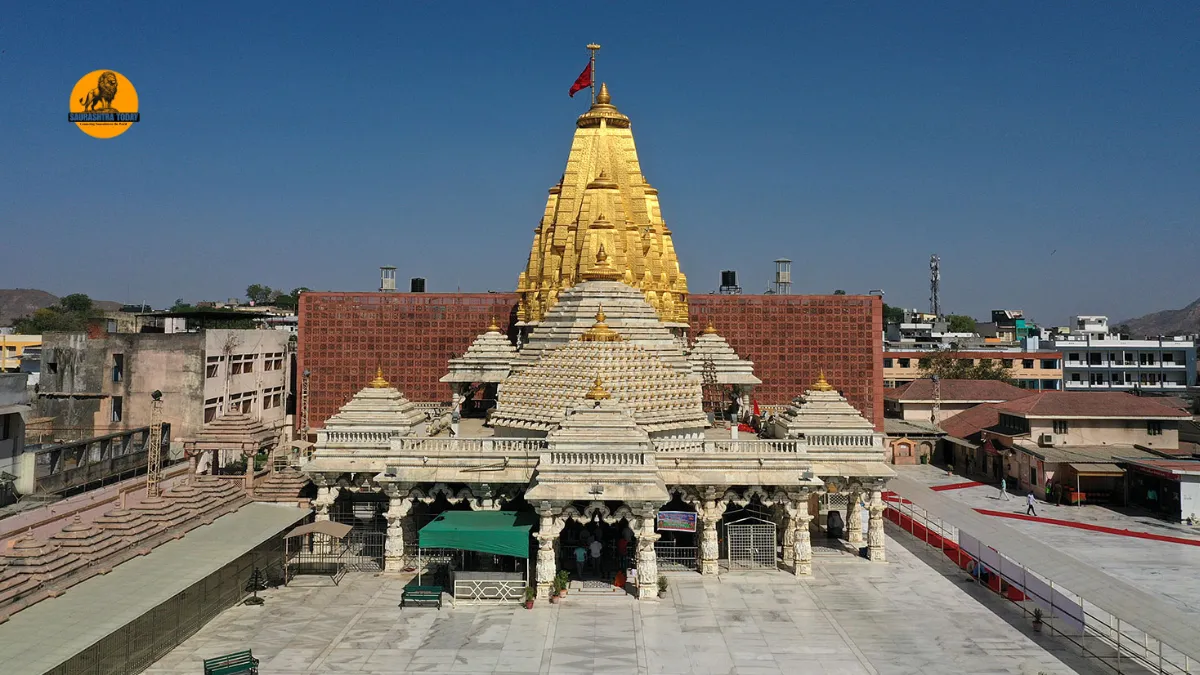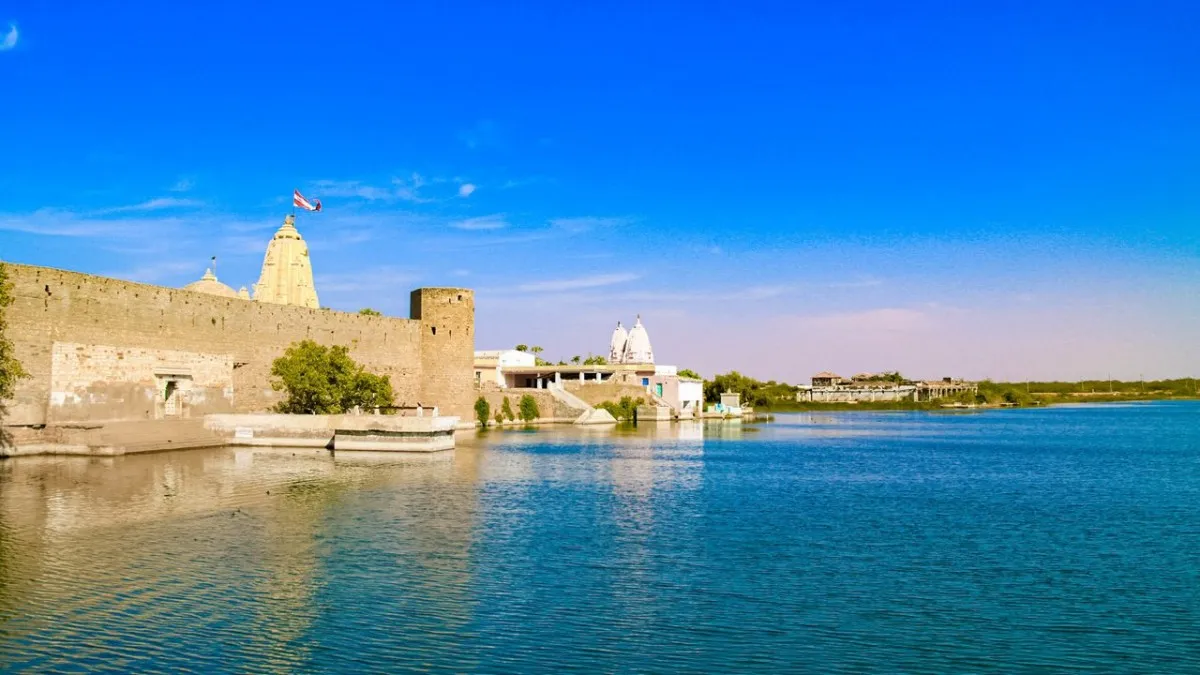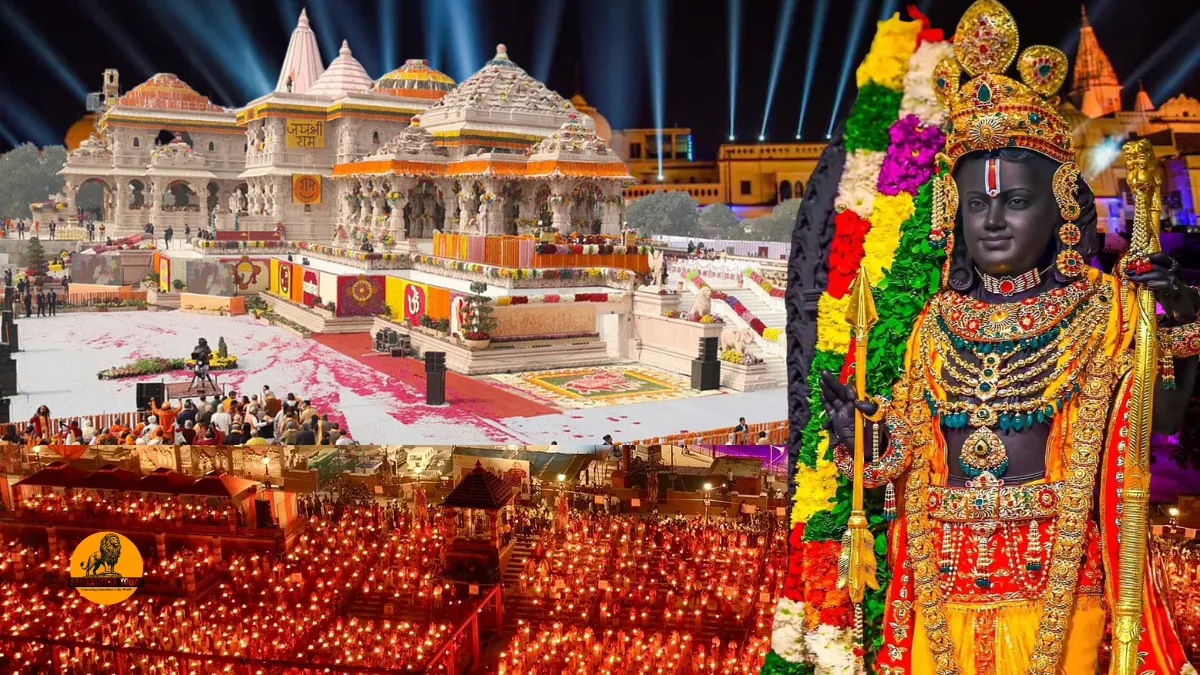Ambaji Aarti Time: Ambaji, located on the border of Gujarat and Rajasthan near Abu Road in Danta Taluka of Banaskantha District, is one of India’s most revered pilgrimage destinations. Known for its religious significance and spiritual aura, Ambaji is home to the Ambaji Mata Temple, one of the 51 Shakti Peethas in India. Pilgrims from across the country visit this sacred site to seek the blessings of Maa Amba and experience the divine energy that surrounds the temple.
Unlike many other temples, the Ambaji Temple does not house a traditional idol of the goddess. Instead, the temple’s priest has decorated the Yantra, the original form of the deity, in such a way that it appears like an idol from afar. Devotees believe that this spiritual representation holds immense power and significance. For detailed insights, visitors often refer to guides on Gabbar Hill and Ambaji Temple timing, which highlight the temple’s unique traditions and historical relevance.
History of Ambaji Temple and Gabbar Hill
The Ambaji Temple holds a prominent place in Hindu mythology. Devotees believe that Gabbar Hill, adjacent to the temple, is where a part of Goddess Sati’s body fell, making the location a sacred Shakti Peeth. According to local legends, the king of Danta was devoted to Maa Amba and frequently climbed the challenging terrain of Gabbar Hill to offer his prayers. Finding the journey difficult, he prayed for the goddess to shift her seat to a more accessible location in Danta city.
The goddess agreed under one condition: the king must lead her from Gabbar Hill to Danta without looking back. As the king walked, he heard the sound of her anklets but eventually doubted if she was following him. When he looked back, the goddess stopped immediately and settled at that spot, which became the present-day Ambaji Temple. Even today, a holy flame continues to burn on Gabbar Hill, drawing pilgrims who wish to pay homage to both the temple and the hill.
This legend underscores the temple’s spiritual importance and highlights why devotees make it a point to visit both sites during their pilgrimage.
Significance of Ambaji Temple
Ambaji Temple holds a special place for followers of Shaktism. The temple is considered a powerful Shakti Peeth, as it is believed that Goddess Sati’s heart fell here during Lord Shiva’s cosmic dance of grief after her demise. Each Shakti Peeth in India has a unique significance linked to a body part of Sati Devi, and Ambaji Temple is celebrated for its spiritual potency.
The temple also has a tantric connection through Batuk Bhairav, a revered deity associated with divine energy. Pilgrims consider visiting Ambaji Temple as an opportunity to receive blessings, experience spiritual upliftment, and participate in rituals that have been performed for centuries. The temple’s rituals, history, and architecture together create an aura that attracts devotees year-round.
Things to Know Before Visiting Ambaji Temple
To make the most of a pilgrimage to Ambaji, visitors should keep the following points in mind:
- Dress Code: Wear traditional or formal clothing, as it is a sacred place.
- Respect Temple Customs: Follow the rules and maintain decorum.
- Carry Essentials: Bring cash for offerings like flowers or prasad.
- Security Checks: Be prepared for thorough checks at the entrance.
- Electronic Devices: Bags, cameras, and gadgets are not allowed inside; use lockers.
- Avoid Scams: Do not trust locals offering quick darshan for money.
- Accommodation: Book lodging near the temple in advance, as the site remains crowded throughout the year.
By adhering to these guidelines, pilgrims can ensure a smooth, spiritual, and fulfilling visit.
How to Reach Ambaji Temple
Ambaji is well-connected by rail, air, and road, making it accessible from various parts of India.
By Rail
The nearest railway station is Abu Road, situated approximately 20 km from the temple. From the station, travelers can hire taxis or auto-rickshaws to reach the temple.
By Air
The closest airport is Sardar Vallabhbhai Patel International Airport in Ahmedabad, about 179 km away. From the airport, taxis and buses provide convenient transportation to Ambaji, with scenic views along the journey.
By Road
Gujarat has excellent road connectivity. The Ambaji Bus Stand is just 14.4 km from the temple, with direct auto-rickshaw services available for visitors. Whether traveling from nearby towns or distant cities, road travel offers an easy and flexible option for pilgrims.
Best Time to Visit Ambaji Temple
The ideal time to visit Ambaji Temple is from September to March, when the weather is pleasant. The temple witnesses a surge of devotees during Navratri, celebrated in September or October, marking a spiritually vibrant period for darshan. Early mornings and evenings provide the most peaceful experience for worshippers. It is advisable to avoid the hot summer months of April to June, as temperatures can be quite high.
Ambaji Temple Timings and Details
To plan your visit effectively, here are the darshan and aarti timings at Ambaji Temple:
Darshan Timings:
- 7:00 AM – 11:30 AM
- 12:30 PM – 4:30 PM
- 6:30 PM – 9:00 PM
Aarti Timings-Ambaji Aarti time
- Mangala Aarti: 6:00 AM
- Rajbhog Aarti: 12:00 PM
- Sandhya Aarti: 7:00 PM
- Shayan Aarti: 9:00 PM
Dress Code: Traditional and formal attire
Photography: Not allowed inside the temple
Prasad: Available for devotees
Festivals:
- Kartik Sud (27 November 2023)
- Chaitra Navratri (22 March 2023 to 30 March 2023)
- Aswin Sud Navratri (19 June 2023 to 28 June 2023)
These timings allow devotees to plan their visit and participate in the daily rituals and aartis, especially the sacred Ambaji Aarti time, which is a spiritually enriching experience.
Exploring Ambaji and Surrounding Areas
While visiting Ambaji Temple, pilgrims often explore the surrounding region to make their journey more fulfilling. Gabbar Hill is a must-visit, offering not only historical and spiritual significance but also breathtaking natural views. Pilgrims climb the hill to witness the site where the goddess is believed to have paused during the legendary journey from Gabbar Hill to Danta.
Local markets around Ambaji are also vibrant, offering traditional souvenirs, religious items, and handcrafted goods. Sampling regional food and sweets adds to the overall cultural experience of the pilgrimage.
Spiritual Practices at Ambaji Temple
Devotees engage in various spiritual practices at Ambaji Temple:
- Offering Flowers and Prasad: Essential part of worship
- Participating in Aarti: Especially during the Ambaji Aarti time, when the temple resonates with devotional chants and hymns
- Meditation and Prayer: Many pilgrims meditate near the Yantra to connect deeply with Maa Amba
- Navratri Celebrations: The nine-day festival is observed with grandeur, attracting thousands of devotees from all over India
These practices foster a deep spiritual connection and provide devotees with a sense of peace, devotion, and divine blessing.
Accommodation Options Near Ambaji Temple
Due to its popularity, Ambaji offers a wide range of accommodation options to suit every budget. Pilgrims can choose from:
- Luxury Hotels: Offering modern amenities with close proximity to the temple
- Guesthouses: Affordable options for longer stays
- Ashrams: Providing a simple, spiritually focused environment for devotees
Booking in advance is recommended, especially during festivals and peak pilgrimage seasons, to ensure a comfortable and hassle-free stay.
Tips for a Memorable Visit
- Arrive early to avoid crowds.
- Carry light clothing and comfortable footwear.
- Respect the temple’s rituals and customs.
- Avoid littering and maintain the sanctity of the site.
- Take time to explore Gabbar Hill for a complete spiritual journey.
Following these tips ensures that every visit to Ambaji Temple becomes a spiritually enriching and memorable experience.
Also read: Palitana Shatrunjaya hill: A Spiritual Journey to Jainism’s Sacred Summit
Conclusion
Ambaji Temple is not just a religious site; it is a symbol of faith, devotion, and divine energy. From its legendary history connected to Gabbar Hill to its daily rituals and the sacred Ambaji Aarti time, the temple provides an unforgettable spiritual experience. Pilgrims and tourists alike are drawn to the temple for its unique Yantra worship, historical significance, and serene environment.
Whether visiting during Navratri or on any other day of the year, Ambaji Temple remains a beacon of devotion, offering blessings, peace, and a profound connection with Maa Amba. For those seeking spiritual fulfillment, a trip to Ambaji is truly a journey of the soul.



















